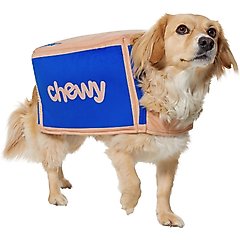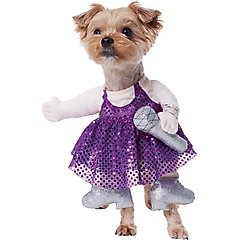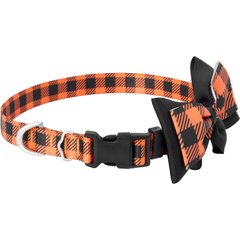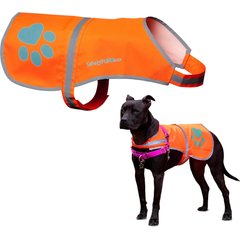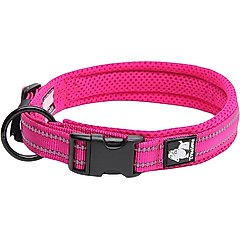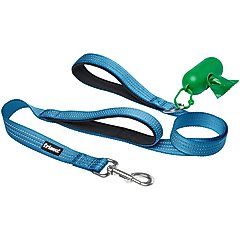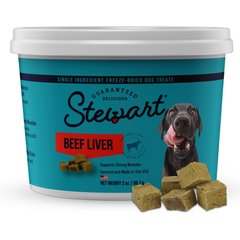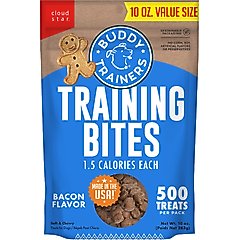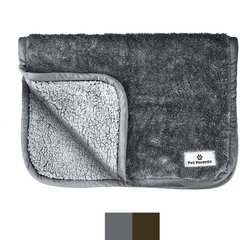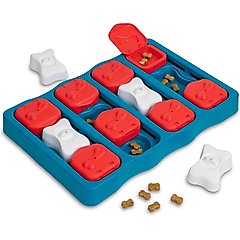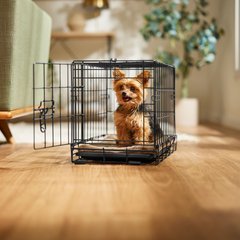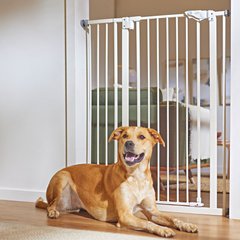11 Tips for Trick or Treating With Your Dog
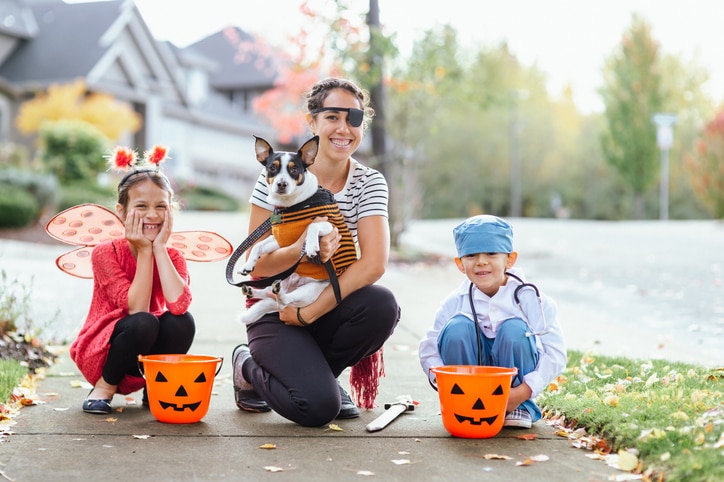
Photo by Fly View Productions/E+
Between the quality time spent with your furry friends, silly and spooky pet outfits, and scary good treats, it’s only natural that you want to do all the fun festivities together to celebrate Halloween—including going trick-or-treating with your dog.
But should dogs go trick-or-treating? We spoke with experts about what to consider before stepping out with your dog on Halloween night, plus safety tips on how to have a spooktacular trick-or-treating experience this Howl-o-ween.
Key Takeaways
- Not all dogs are suited for trick-or-treating. Consider your pup’s personality and comfort level.
- Ensure your dog wears safe, reflective gear and is always kept on leash.
- Keep treats handy for positive reinforcement, and avoid exposure to Halloween hazards like candy and decorations.
- Watch for signs of stress, and have a plan to return home early if needed.
Can I Trick or Treat With My Dog?
Before trick-or-treating with your dog, take their temperament into account, says Sally Grottini, a professional dog trainer and former AKC Canine Good Citizen evaluator in Riverside, Pennsylvania.
If your dog is on the shy side or gets easily spooked, consider doing something fun for them at home instead to keep them—as well as children and others in your neighborhood—comfortable and safe. For instance, you could host a dog Halloween party, whip up some dog-friendly Halloween treats, or watch Halloween movies featuring pets.
If your dog is well-socialized, they might be able to comfortably accompany you to go trick-or-treating at a dog-friendly venue or around the neighborhood.
Before trick-or-treating with your dog, Grottini recommends making sure your dog is comfortable with the following:
- Halloween decorations: If you’re not sure how your dog will react to decorations, take them out before Halloween. Allow your dog to get familiar with the decorations in your neighborhood, and watch their body language. Signs like a dropped tail or ears flattened against their head mean they’re scared and unsure. Any resistance to getting closer to a decoration will indicate they’re uncomfortable.
- People in costume: Costumes can be distressing for dogs, even if they know the person behind the mask. Put on your own costume in advance or take your dog to meet other people in costumes prior to Halloween, so you know how they’re likely to react.
- Crowds: Even the quietest residential neighborhood can become packed with trick-or-treaters on Halloween. If your dog is uncomfortable in crowds, it’s best to leave them out of the trick-or-treating festivities.
11 Tips for Trick or Treating With Your Dog
Want your dog to join the fun this spooky season?
Follow these tips to have a successful trick-or-treat adventure with your pup.
1. Choose Safe and Comfortable Costumes
Whether you’re thinking of dressing your dog as a friendly ghost, Count Barkula, or any other dog costume, safety and comfort should take priority over cuteness. (Because really, your pooch will look absolutely adorable regardless of their costume!)
Sabrina Kong, DVM, a veterinarian at Jules Veterinary Center in Tracy, California, shares how to choose the best Halloween costume for your dog:
- Prioritize unrestricted movement: Check that your dog can walk, sit, and breathe easily. Costumes shouldn’t bind your dog’s legs, neck, or chest.
- Avoid masks or headpieces that limit vision or hearing: Your dog should be able to see and hear clearly, since they heavily rely on these senses to feel secure.
- Inspect for hazards: Check that the costume doesn’t have loose buttons, strings, or small decorations that could pose choking risks if chewed or swallowed.
Recommended Products
Once you’ve found a costume that may be appropriate for your furry monster, introduce them to it slowly. You can train your dog to wear clothing and costumes. Some dogs tolerate it—and even like it!
However, if your dog shows signs of stress, such as excessive panting, frozen posture, or attempting to rip off the outfit, skip it, Dr. Kong says. Simple pet Halloween accessories like a themed Halloween collar or bandana often work better for sensitive pups.
Recommended Product
2. Wear Reflective or Night-Safe Accessories
Data from the National Highway Traffic Safety Administration (NHTSA) has shown that Halloween is one of the most dangerous days for pedestrians. Use dog reflective gear, like vests, collars, and leashes, to make yourself and your pet more visible at night, especially on a night as chaotic and dimly lit as Halloween.
Recommended Products
“Reflective gear makes your dog visible from all angles, especially if they dart toward dropped candy or a distraction,” Dr. Kong says. “This isn’t just about convenience; it’s lifesaving.”
If you choose to go trick or treating with your dog, she recommends pairing reflective gear with a secure harness—not just a collar—to prevent escapes if your pooch gets startled.
Recommended Product
3. Bring Treats for Good Behavior
No tricks, just treats for your canine companion this Halloween! Dog treats are a great way to reward your dog for a job well done.
Whenever you’re trying something new with your dog, especially in a busy area, always use high-value treats and give training cues consistently so your dog focuses on you, Grottini says.
High-value treats are any that your dog finds extremely tasty. If your pup goes wild for Stewart beef liver freeze-dried treats or Buddy Biscuits bacon-flavored dog treats, for example, keep those on hand.
Recommended Products
4. Avoid Large Crowds and Heavy Traffic
If your dog isn’t used to large crowds—and even if they are—there’s always a possibility that they can become overwhelmed by the rowdy revelers, heavy traffic, and scary sights and sounds on Halloween.
If you notice your dog becomes uncomfortable in a crowd, move them away from the crowd while giving them “heel” and “watch me” cues. Reward them for following your instructions with treats and praise.
Continue to reward your dog for listening to you while you two move to a quieter spot. Giving commands and rewards helps your dog pay more attention to you than the crowd.
It’s best to make sure that your dog is used to crowds before taking them trick-or-treating. Grottini recommends bringing them first to a gathering with a calm crowd, such as a line to go into a store during a sale.
5. Keep Your Dog on Leash
Depending on where you’re trick-or-treating with your dog, Halloween night can be filled with unpredictability for pets.
Loud sounds, such as firecrackers, music, or sound effects, can be frightening, so it’s important to keep your dog safe and prepare for the unexpected by always keeping them on a leash—even if they’re well-trained, Grottini says.
6. Watch for Hazards
Halloween is filled with frights and fun for us, but there are many hazards for dogs, especially in high-traffic areas.
According to Dr. Kong, these risks include:
- Dropped candy: All candy is dangerous for dogs to eat. Train your dog to “leave it” and carry high-value treats to redirect their attention.
- Glow sticks: Glow sticks contain bitter chemicals that cause drooling, vomiting, or oral irritation if punctured. If contact occurs, rinse your dog’s mouth with water.
- Candles: Real flames can ignite fur or cause burns if a curious pup brushes against them. Opt for battery-operated flameless lights rather than burning candles in jack-o’-lanterns.
- Discarded wrappers: Discarded candy wrappers can cause intestinal blockages if swallowed. Scan yards for wrappers to ensure your dog doesn’t get hold of them.
- Small decorations: Small decorations like plastic spiders or fake cobwebs can also cause intestinal blockages if swallowed. Look out for these to prevent accidental chewing or ingestion.
Other ways to keep your dog safe while trick-or-treating include keeping them on a non-retractable leash and close by to make sure they’re not eating items off the ground, says Sarah Vigil, DVM, lead veterinarian and partner at CityVet – Brushy Creek in Round Rock, Texas.
7. Brush Up on Essential Training Skills
Your dog should be well trained on their recall prior to trick-or-treating.
“Even the most well-adjusted dog can be frightened by a sudden event, such as a loud bang,” Grottini says. “This can cause them to break loose from you and run away, as this is their first instinct when they are scared.”
“Leave it” and “drop it” are other commands a dog should know:
- “Leave it” can be used to stop them from going after whatever they see on the ground or chasing after cars, animals, or people.
- “Drop it” teaches them to release what’s in their mouth.
8. Check That Your Dog’s Microchip Information Is Up to Date
Much like the 4th of July, Halloween can be a stressful and dangerous holiday for pets. It’s common for dogs to end up lost on Halloween, Dr. Vigil says. Keeping a dog’s microchip information current can reunite them with their family if they go missing.
To update your pet’s microchip information with your address and phone number, contact the microchip’s manufacturer.
9. Watch for Signs of Stress and Keep the Night Short
Dogs experience the world with heightened senses. This can lead to certain sights and sounds causing them stress. Being able to pinpoint when your pooch might be feeling uncomfortable or anxious is crucial for their safety and well-being, as well as knowing when it’s a good idea to return home.
Dr. Kong breaks down signs of stress in dogs to watch for:
Early stress cues
- Excessive panting
- Yawning
- Whining
- Trembling
Red flags
- Flattened ears
- Tucked tail
- Resisting moving (“freezing”)
Escalated signs demanding an immediate retreat
- Cowering
- Attempting to bolt
- Growling at costumed people
- Repetitive behaviors (e.g., obsessive licking)
“Forcing a stressed dog to continue [trick-or-treating] can trigger aggression or panic-induced escapes,” Dr. Kong says. “At the first sign of discomfort, leave quietly. Back home, offer a dark, quiet space with a favorite blanket or puzzle toy to decompress.”
Recommended Products
10. Be Prepared for Potty Breaks
Potty breaks are a must any time you’re in public with your pup. If your dog shows signs that they need to do their business, like sniffing or circling, take them to an appropriate area:
- If you’re attending a dog-friendly trick-or-treating event, check for designated potty spots or relief stations your dog can use.
- If you’re trick-or-treating in a neighborhood, take them to a public spot, like along a curb or a park.
No matter where you and your dog go trick-or-treating, always bring dog poop bags, like Earth Rated unscented dog poop bags, and properly dispose of their poo.
Recommended Product
11. Keep Candy Away From Your Dog When You Arrive Home
Halloween candy should be kept out of your dog’s reach when you get home from trick-or-treating. All candy is unsafe for dogs to eat—but some is lethal, Dr. Kong says. This includes:
- Chocolate: Chocolate contains theobromine and caffeine, which can cause mild symptoms such as vomiting and diarrhea, but at higher doses can lead to heart and neurologic issues. Dark chocolate, cocoa, and baking chocolate contain more of these compounds.
- Sugar-free treats: Sugar-free candies and baked goods are often made using xylitol, which is toxic to dogs. Xylitol can trigger hypoglycemia (aka low blood sugar), neurologic issues, or liver failure. Even one piece can be fatal for small dogs.
- Trail-mix candies containing raisins or macadamia nuts: Raisins (and grapes) can cause kidney failure, while macadamia nuts may result in neurological issues in dogs.
If you need to, keep your dog in a dog crate or behind a dog gate while you and your family enjoy your Halloween candy.
Recommended Products
Other foods and beverages dogs should not have include:
- Alcohol
- Ice cream and other dairy products
- Salty foods

